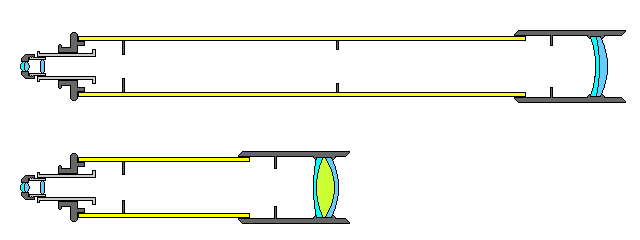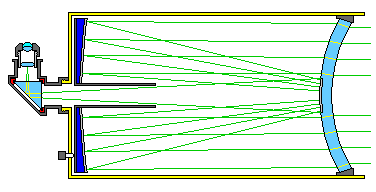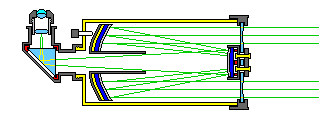
There are many different kinds of telescope.
In the refracting telescope, the objective lens is usually composed of two lenses, made out of different kinds of glass. Such a lens is called an achromat. A glass prism can be used to produce a rainbow of colors from white light. This is because glass bends different colors of light to different degrees.
When one wants to have a clear and sharp image of something one is looking at, this effect becomes an annoyance, known as chromatic aberration. An achromat is designed to cancel this effect, by using lenses made of two different kinds of glass. One lens is convex, made of crown glass. The other is concave, made of flint glass, which is denser, and which bends light more strongly, if made into a lens of the same shape, than crown glass. However, not only does it bend light more strongly, but the difference in how it bends lights of different colors is also more pronounced, even in proportion to the increased amount of bending.
Thus, two lenses close together, one of flint glass, and one of crown glass, bending light in opposite ways, can be made so that the difference in bending different colors cancels out, but the lens itself still performs a net function of bending the light that goes through it in one direction.
However, because the behavior of light of different colors in glass doesn't follow a simple fixed law, this cancellation can only be exact for two colors. This still gives a great improvement over a plain lens. But sometimes a larger improvement is desired, and then a lens is designed out of three elements of three different kinds of glass. Such a lens is called an apochromat, and these are used as objective lenses on some more expensive telescopes.
The objective lens on a telescope, instead of being like an ordinary magnifying glass lens in profile, equally fat on both sides, usually has a crescent-shaped profile, and such a lens is called a meniscus lens.
This is done to minimize another aberration, called spherical aberration. The bending of light by a lens is due to the mathematical law called Snell's law, and is due to the fact that light travels more slowly in glass than it does in air.
A spherical surface is relatively easy to produce when grinding lenses, but it is only an approximation to the shape of a surface that would focus incoming rays of light to a single point in an image.
Sometimes, particularly when many lenses are being manufactured for a fixed purpose, by being molded from plastic, it is worth the expense to make the mold the exact shape needed to produce the ideal surface for bending light to form an image. Lenses like this are called aspheric lenses. Sometimes such lenses are even made from glass for special purposes, but such lenses are expensive, and thus not commonly used.
The term aspheric, because it means "not spherical", is sometimes applied to other kinds of lenses which are not as difficult to make. They still have curved surfaces which are circles instead of the complicated curves needed to make perfect images. For example, you may have seen cylindrical lenses that can make a line of printing taller, even though they don't make it wider. Such lenses can make optical instruments that do one thing in one direction, and a different thing in another.
One application of this is the anamorphic lenses that are used to squeeze in the wide picture on a movie screen (2.35 times as wide as it is tall) in the frame of motion picture film designed for the original motion picture aspect ratio that is 1.33 times as wide as it is tall, like the screen on your TV set. (Actually, since Edison, motion picture standards were changed slightly to make the regular film aspect ratio 1.37:1; however, movies in the 2.35:1 aspect ratio are recorded in an area on the film that is actually only 1.175 times as wide as tall, because not only is the picture wide and spectacular, but the film also carries several extra sound tracks as well.)
Another application of this is eyeglasses. The lenses in eyeglasses are usually toroidal rather than spherical, so that they can correct not only for a wrong overall focal length in the lens of the eye, but for differences in that focal length in different directions, or astigmatism.
Usually, telescope objective lenses in refracting astronomical telescopes don't use aspheric elements.
Two examples of a refracting telescope are illustrated below:

A thin lens has less spherical aberration than a thick one. Even after correcting for chromatic aberration has made the two elements of the objective somewhat thicker than a lens consisting of only one element would be, spherical aberration is still fairly low. Making the objective a meniscus lens minimizes it, because then the overall shape of the lens follows the curve of the surface where the incoming rays of light would be bent into their new desired direction while retaining a uniform spacing between them. (Of course, why that should make a difference is complicated.)
It may also be noted that the curves on the lenses in the diagram above are exaggerated for purposes of illustration.
When the front surface has to be more strongly convex, in the shorter-focus telescope shown in the lower part of the diagram, balancing the bending between the two surfaces leads to the rear surface being convex instead of concave, but with a less strongly curved surface. This telescope needs a third element, either made from calcium fluorite or from a special type of glass, to compensate more thoroughly for the tendency of glass to bend blue light more strongly than yellow light, and yellow light more strongly than red light. With two elements, an achromatic lens can bring both red and blue light to the same focus, but yellow light, instead of also being focussed at the same spot, is, as long as ordinary crown and flint glasses are used, bent more strongly, and brought to a focus sooner. Using three elements, and more importantly, one element that is not an ordinary glass, not only allows three colors to be brought to the same focus, but also leads, when this is done, to the colors in between having much less error as well.
This type of lens is, as noted above, an apochromat. It is possible to design an apochromatic lens without using fluorite or a similar material. Plastics, such as acrylic, also differ from optical glass in their secondary spectrum, although they have the weakness of being much more sensitive to temperature than glass. Also, there are differences between ordinary optical glasses that would allow them to be used to construct an apochromat as well; H. Dennis Taylor designed a photo-visual objective in 1895 which did not require either fluorite or a fluor crown.
Because fluorite differs more strongly from ordinary glasses, however, an apochromat which uses fluorite (again, or a glass that closely resembles it) does not need to have surfaces that are as strongly curved to achieve the same focal length: the positive and negative elements of the lens do not need to come quite so close to cancelling out each other's powers. This determines the other aberrations the lens would have. The apochromat of H. Dennis Taylor was designed for use in an f/16 telescope, a length at which most people will settle for an achromatic refractor, which already provides excellent views. A three-element apochromat with a fluorite-like element, on the other hand, allows a telescope to be made that will deliver impressive views at a focal ratio of f/6, and two-element lenses which reduce chromatic aberration through using a fluorite-like element, even if one might question the use of the term 'apochromat' in describing them, can still do the same at f/9.
The next common type of telescope, the Newtonian telescope, does usually make use of an aspheric element. In the Newtonian telescope, the place of the objective lens is taken by a concave mirror, which can magnify and form images in much the same way as a convex lens. An extra mirror, a small flat mirror called the diagonal, is used to keep the head of the person using the telescope out of the way of the incoming light.
This type of telescope is illustrated below:

In the Newtonian telescope, the mirror which functions as the objective, called the primary mirror, usually is not left as spherical, but is carefully adjusted during grinding to take on a parabolic shape. (Thus, this adjustment step is called parabolizing the mirror.)
Another kind of telescope is known as the Maksutov telescope. This design has been used for some very expensive telescopes of modest size; recently, more affordable telescopes of this type have become available. It has a very good reputation for optical quality. In this telescope, the primary mirror is left as spherical. A thick glass element at the front of the telescope, with the same curvature on the front and back, acts as a corrector for the spherical aberration of the mirror.
The particular form of Maksutov telescope illustrated below also has a circular spot in the center that is coated on the inside to be a mirror; this mirror reflects the light that would normally be brought to a focus shortly beyond it, and, because of its curvature, delays the focusing of the reflected light until it goes out the back of the telescope through a hole in the center of the primary mirror.

Some effort has been made to draw this diagram to scale, based on the actual design in Dimitri Maksutov's notebooks. However, the distance from the mirror surface out of the back of the telescope to the focal plane in the eyepiece is still exaggerated.
This particular form of Maksutov-Cassegrain telescope is generally known as the Gregory-Maksutov telescope, as it was John Gregory's design including a silvered spot that first became well-known in the West. The design shown in the illustration above is for an f/9 telescope; telescopes of this type sold at present tend to have focal ratios from f/14 to f/14.8 instead, which also helps provide the superior optical quality associated with them.
A similar, but less expensive, and thus highly popular kind of telescope is called the Schmidt-Cassegrain telescope. Here, instead of a thick piece of glass with two spherical surfaces, correction is provided by a very thin piece of glass, flat on one side, and with an aspheric surface on the other.

Here, the mirror for reflecting the light back through the end of the telescope is bolted to the front element. This type of telescope generally has an f/10 focal ratio with an 8" (or 200mm) or larger aperture; one with a 4" (or 100mm) aperture might have a slightly slower focal ratio of f/12.
Copyright (c) 2001, 2002, 2006 John J. G. Savard